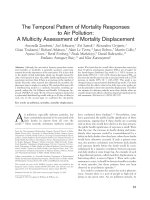Capacity of Wireless Channels potx
Bạn đang xem bản rút gọn của tài liệu. Xem và tải ngay bản đầy đủ của tài liệu tại đây (1.14 MB, 33 trang )
1
5: Capacity of Wireless Channels
Fundamentals of Wireless Communication, Tse&Viswanath
5. Capacity of Wireless Channels
2
5: Capacity of Wireless Channels
Fundamentals of Wireless Communication, Tse&Viswanath
Information Theory
•
So far we have only looked at specific communication
schemes.
•
Information theory provides a fundamental limit to
(coded) performance.
•
It succinctly identifies the impact of channel resources on
performance as well as suggests new and cool ways to
communicate over the wireless channel.
•
It provides the basis for the modern development of
wireless communication.
3
5: Capacity of Wireless Channels
Fundamentals of Wireless Communication, Tse&Viswanath
Historical Perspective
•
Wireless communication
has been around since
1900’s.
•
Ingenious but somewhat
adhoc design techniques
Claude Shannon
Gugliemo Marconi
•
Information theory says every
channel has a capacity.
•
Many recent advances based
on understanding wireless
channel capacity.
New points of views arise.
1901
1948
4
5: Capacity of Wireless Channels
Fundamentals of Wireless Communication, Tse&Viswanath
Multipath Fading: A Modern View
Classical view: fading channels are unreliable
Modern view: multipath fading can be exploited to
increase spectral efficiency.
16dB
5
5: Capacity of Wireless Channels
Fundamentals of Wireless Communication, Tse&Viswanath
Capacity of AWGN Channel
Capacity of AWGN channel
If average transmit power constraint is watts and
noise psd is watts/Hz,
6
5: Capacity of Wireless Channels
Fundamentals of Wireless Communication, Tse&Viswanath
Power and Bandwidth Limited Regimes
Bandwidth limited regime capacity logarithmic
in power, approximately linear in bandwidth.
Power limited regime capacity linear in power,
insensitive to bandwidth.
7
5: Capacity of Wireless Channels
Fundamentals of Wireless Communication, Tse&Viswanath
8
5: Capacity of Wireless Channels
Fundamentals of Wireless Communication, Tse&Viswanath
Example 1: Impact of Frequency Reuse
•
Different degree of frequency reuse allows a tradeoff
between SINR and degrees of freedom per user.
•
Users in narrowband systems have high link SINR but
small fraction of system bandwidth.
•
Users in wideband systems have low link SINR but full
system bandwidth.
•
Capacity depends on both SINR and d.o.f. and can
provide a guideline for optimal reuse.
•
Optimal reuse depends on how the out-of-cell
interference fraction f(ρ) depends on the reuse factor ρ.
9
5: Capacity of Wireless Channels
Fundamentals of Wireless Communication, Tse&Viswanath
Numerical Examples
Linear cellular system Hexagonal system
10
5: Capacity of Wireless Channels
Fundamentals of Wireless Communication, Tse&Viswanath
Example 2: CDMA Uplink Capacity
•
Single cell with K users.
•
Capacity per user
•
Cell capacity (interference-limited)
11
5: Capacity of Wireless Channels
Fundamentals of Wireless Communication, Tse&Viswanath
Example 2 (continued)
•
If out-of-cell interference is a fraction f of in-cell interference:
12
5: Capacity of Wireless Channels
Fundamentals of Wireless Communication, Tse&Viswanath
Uplink and Downlink Capacity
•
CDMA and OFDM are specific multiple access schemes.
•
But information theory tells us what is the capacity of the
uplink and downlink channels and the optimal multiple
access schemes.
17
5: Capacity of Wireless Channels
Fundamentals of Wireless Communication, Tse&Viswanath
Frequency-selective Channel
's are time-invariant.
OFDM converts it into a parallel channel:
where is the waterfilling allocation:
with λ chosen to meet the power constraint.
Can be achieved with separate coding for each sub-carrier.
18
5: Capacity of Wireless Channels
Fundamentals of Wireless Communication, Tse&Viswanath
Waterfilling in Frequency Domain
19
5: Capacity of Wireless Channels
Fundamentals of Wireless Communication, Tse&Viswanath
Slow Fading Channel
h random.
There is no definite capacity.
Outage probability:
−outage capacity:
20
5: Capacity of Wireless Channels
Fundamentals of Wireless Communication, Tse&Viswanath
Outage for Rayleigh Channel
Pdf of log(1+|h|
2
SNR) Outage cap. as fraction of AWGN cap.
21
5: Capacity of Wireless Channels
Fundamentals of Wireless Communication, Tse&Viswanath
Receive Diversity
Diversity plus power gain.
22
5: Capacity of Wireless Channels
Fundamentals of Wireless Communication, Tse&Viswanath
Transmit Diversity
Transmit beamforming:
Alamouti (2 Tx):
Diversity but no power gain.
23
5: Capacity of Wireless Channels
Fundamentals of Wireless Communication, Tse&Viswanath
Repetition vs Alamouti
Repetition:
Alamouti:
Loss in degrees of freedom under repetition.
24
5: Capacity of Wireless Channels
Fundamentals of Wireless Communication, Tse&Viswanath
Time Diversity (I)
Coding done over L coherence blocks, each of many
symbols.
This is a parallel channel. If transmitter knows the
channel, can do waterfilling.
Can achieve:
25
5: Capacity of Wireless Channels
Fundamentals of Wireless Communication, Tse&Viswanath
Time Diversity (II)
Without channel knowledge,
Rate allocation cannot be done.
Coding across sub-channels becomes now necessary.
26
5: Capacity of Wireless Channels
Fundamentals of Wireless Communication, Tse&Viswanath
Fast Fading Channel
Channel with L-fold time diversity:
As
Fast fading channel has a definite capacity:
Tolerable delay >> coherence time.
27
5: Capacity of Wireless Channels
Fundamentals of Wireless Communication, Tse&Viswanath
Capacity with Full CSI
Suppose now transmitter has full channel knowledge.
What is the capacity of the channel?
28
5: Capacity of Wireless Channels
Fundamentals of Wireless Communication, Tse&Viswanath
Fading Channel with Full CSI
This is a parallel channel, with a sub-channel for each
fading state.
is the waterfilling power allocation as a function of
the fading state, and λ is chosen to satisfy the
average power constraint.
where
Can be achieved with separate coding for each fading
state.
29
5: Capacity of Wireless Channels
Fundamentals of Wireless Communication, Tse&Viswanath
Transmit More when Channel is Good









